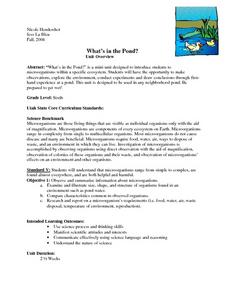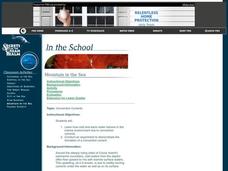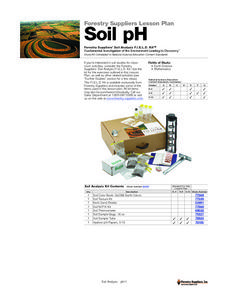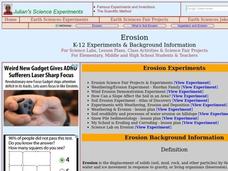Curated OER
How Hot is Too Hot?
Fifth graders use the scientific method to conduct experiments on the temperature effects on organisms. In this temperature effects on organisms lesson plan, 5th graders observe and record the hatching or the developing of organisms into...
Curated OER
What's in the Pond?
Sixth graders are introduced to microorganisms within a specific ecosystem and have the opportunity to make observations, explore the environment, conduct experiments and draw conclusions through firsthand experience at a pond. They also...
Curated OER
Fungus
Students study fungus, its reproduction and uses. In this eukaryote instructional activity students complete several fungal experiments.
Curated OER
Burning Snacks in Chem Lab
Students determine the energy content of various snack foods. They measure the temperature changes in various snack foods as the foods are burned in order to determine the foods' energy content. Students create graphs and data tables of...
Curated OER
Hot and Cold Colors
Students engage in an activity that will allow them to observe that hotter conditions can speed up changes in materials. They will predict whether food coloring disperses more quickly in hot, cold, or room temperature water, and then...
Curated OER
People and Space
Students eat dehydrated foods that the astronauts would eat in space. In this dehydrated foods lesson plan, students make lists of food they could eat, discuss how dehydration takes place, eat food, and complete discussion questions.
Curated OER
Who's Coming to Lunch: A Study of Mold Growth
Students participate in an experiment to determine where fungi and molds are formed, and create graphs documenting fungal growth.
Curated OER
Feed Your Cells
Students examine and research the human digestive system and what happens to the food we eat. They read the article, The Passage of Food, participate in an experiment with crackers, and write a paragraph summarizing the function of the...
Alabama Learning Exchange
Air is All Around You
Pupils investigate the mysteries of air. In this science lesson, students participate in hands-on activities that require them to use the scientific inquiry model to study air.
Curated OER
Secrets of the Ocean Realm - In the School "Mountain in the Sea"
Students learn how cold and warm water behave in the marine environment due to convection currents. Students also conduct an experiment to demonstrate the formation of a convection current.
Curated OER
Root, Root, Root for the Nutrients
Students observe the growth of a seed, predict what will happen when seeds are planted without soil, and conduct an experiment using a hydroponics system.
Curated OER
Out of the Deep
Learners observe, describe, and record characteristics of ocean animals (mammals and fish) and sea shells. They conduct an experiment comparing and contrasting sugar water, salt water and fresh water and create a mural of coral reef...
Curated OER
Human Needs
Pupils investigate human needs and how they have adapted to different environments. They complete an experiment to discover the effect of stress on muscles. They use the food pyramid to create a plan for healthy eating.
Curated OER
Flavors and Favors
Students conduct a food drive. In this service learning lesson, students put on a school-wide food drive, decorate the bags the food will be delivered in and possibly even help distribute the food.
Curated OER
Mushroom
Students identify the different types of mushrooms. In this biology lesson, students explore different mushroom experiments they can do at home. They discuss ways to extend sliced mushrooms' shelf life.
Curated OER
Sensational Slime
Students predict, observe and draw conclusions while working on an experiment with "slime." Students accurately record observations and draw conclusions about the experiment.
Curated OER
Aztec Floating Gardens
Aztecs created amazing hydroponic gardens called Chinampas, to grow their crops. Learners in grades k-7 engage in four mini-experiments to understand just how amazing floating gardens are. Tip: A perfect way to bring science into your...
Curated OER
Ice Mummies: Frozen in Heaven
Students conduct an experiment to investigate the rate of microbial growth at different temperatures. Students predict what will happen to the food at various temperature and test their hypotheses. Students describe the differences in...
Curated OER
Fracture Fundamentals: A Cheesy Analog
Students make small cuts (fracture nuclei) in processed cheese food and then apply stresses perpendicular or parallel to the cuts to see how fractures grow. They make predictions before each experiment and explain their results to the...
Curated OER
Forestry Suppliers
Students explore the scientific reasons that certain types of foods cause different reactions when they interact with the tongue. They analyze the differences between acids and basics. The experiment is performed at three different sites...
Curated OER
Soggy Seeds
Students conduct experiments to learn about seed germination. In this seed germination lesson, students write a hypothesis for the seed experiment. students complete the experiment for seed germination and graph the data obtained from...
Curated OER
Erosion
Students examine soil erosion and what causes it. In this soil lesson students complete several experiments on soil erosion and the weathering process.
Curated OER
Bubble and Squeak
Students complete a unit on the chemical and technological processes of food preparation. They observe various experiments, describe changes in materials through cooking, identify safety and hygiene issues, and cook various recipes.
Curated OER
Altogether, Now
Pupils apply their five senses to science, math, drama, and writing center activities.

























